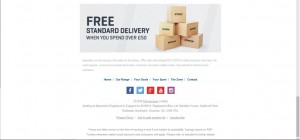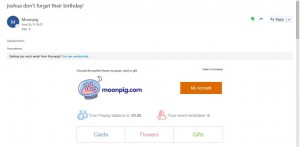Social media has become a huge part of everyone’s day to day life. But the use of social media can now be used to massively benefit organisations, especially new fashion brands. In recent years organisations have realised that there is no other medium that can reach so many people in such little time as social media can, whilst ‘keeping marketing costs at their lowest’ (Funk, 2011). Interestingly though, Funk (2011) explains that the channels of social media marketing are ‘not as important for selling’ but crucial for ‘listening to customers’ and ‘communicating your brand directly and personally’. The importance of listening to customers in the modern business environment is paramount, as a positive social media presence reaches out to existing and potential future customers. Often large fashion brands can seem unreachable in terms of a personal social media presence, and this is an area to exploit for smaller brands who cannot compete with the costs of global marketing campaigns. In the modern business environment customers, more than ever, can be vocal about their opinions and experiences with a brand. For a fashion brand it is important therefore, to be transparent and create a relationship and sustainable connection with the public.
When promoting a new fashion brand on social media, the most difficult challenge is to build awareness and a positive reputation with consumers. If this reputation is negative e.g. poor quality or poor customer service, this will have a detrimental effect on potential growth and success in industry. However, Morin (2014) suggests the notion that negative reviews can be good for small businesses, and that they should be embraced not feared. Especially considering that the clothing industry involves purchases which involve different fittings and sizes, therefore customer complaints and returns are likely to occur.
Contrastingly, if the social media perception of the brand is positive then the trust and interest of the brand is enhanced perhaps even before a consumer has purchased an item of clothing themselves. Word of mouth marketing is a key tool for successfully marketing on social media, as ‘84% of consumers trust family and friends about the quality of products’ (Grinnell, 2014). Twitter and Facebook provide a platform to leave positive reviews and comments which will reach to their followers and potential new customers. The reviews and comments also provide more credibility for brands as social media followers can see they are real people, with real views representative of similar customers. With so many large fashion retailers, this aspect of marketing can help a smaller niche brand to gain a competitive advantage by being reliable and connected with their customers.
Fashion brands must consider which social media marketing strategy best suits them. It is reported that Instagram is the most popular platform for fashion brands, but this will ultimately depend on ‘usability’ and ‘how it keeps in line with the long term strategic plans (Roderick, 2016).
Examples of Best Practice- Facebook and Twitter
Burton’s Facebook Page- Call To Action Offers
Fresh Ego Kid Twitter- Personalisation
Risk Couture Twitter- Associated hashtags to increase visibility
Social media has the ability to reach millions of customers immediately, and research has shown that if you ‘follow a brand on Instagram you are, finances permitting, 53% more likely to shop with them’ (Rasmussen, 2016). In the current market place this is an incredibly simple but effective way to grow sales and grow the brand into a much larger business. Especially when first establishing the brand within the crowded market, reputation and market growth will be affected by how successfully the social media channels are managed.
Potential Risks
Of course, there are many risks that a new fashion brand would have to be careful of when utilising social media marketing (Robinson, 2013);
- PR Crisis- this would damage the brand image
- Security Breach- potential costs to ensure security
- Offending your audience- when posting non-business material it must not offend customer base
- Competition- clothing industry means you have to be careful not to have original designs copied
- Legal Implications- be aware of legal boundaries and that content is publishable e.g. not copyright
The short video below shows the future marketing trends that organisations can expect in 2017. It provides an interesting insight into customer engagement and the huge audiences available to new fashion brands on Facebook and Snapchat.
Give it a watch!
(Source: WeeklyMarketingTips, 2017).
Meyers (2017) suggests that fashion brands should utilise best practice to ensure that their social media marketing strategy is a success. The key points presented are that brands must ‘tailor’ their message, ‘be yourself’ and to ‘tell a story about the customers lifestyle (or the one they wish they had)’. This simple theory helps to create a strategy that will help to establish a fashion brand to its customers. By tailoring the message, this allows for the brand to be easily communicated with potential customers but also creates a risk-averse approach which does not attempt to do anything other than positively advertise the brand. By representing the brand in a positive and innovative way on social media, it is possible to create a trust with the consumer and therefore would be more likely to create a long lasting relationship.
Thanks for reading! You can follow me on Twitter- @JR_DIGMARK
References
Funk, T (2011). Social Media Playbook For Businesses. London: Praeger. p15-22.
Grinnell, B. (2014). 4 Benefits of Word-of-Mouth Marketing. Available: http://www.twolegit.com/4-benefits-word-mouth-marketing/. Last accessed 22nd Feb 2017.
Meyers, S. (2017). 6 Social Media Tricks of Fashion Brands. Available: http://www.inc.com/stephanie-meyers/6-social-media-tricks-fashion-brands.html. Last accessed 22nd Feb 2017.
Morin, A. (2014). Why Negative Reviews Can Be Good For Business. Available: http://www.forbes.com/sites/amymorin/2014/05/06/why-negative-reviews-can-be-good-for-business/#52ed09d63b27. Last accessed 22nd Feb 2017.
Rasmussen, T. (2016). how important is social media in building a fashion brand and business?. Available: https://i-d.vice.com/en_gb/article/how-important-is-social-media-in-building-a-fashion-brand-and-business. Last accessed 22nd Feb 2017.
Robinson, C. (2013). The Risks Associated with Social Media Marketing. Available: http://www.business2community.com/social-media/risks-associated-social-media-marketing-0617722#wGz0rXXUYbstvypq.97. Last accessed 22nd Feb 2017.
Roderick, L. (2016). How fashion brands are taking Instagram from gimmick to strategic. Available: https://www.marketingweek.com/2016/02/17/how-fashion-brands-are-taking-instagram-from-gimmick-to-strategic/. Last accessed 22nd Feb 2017.










